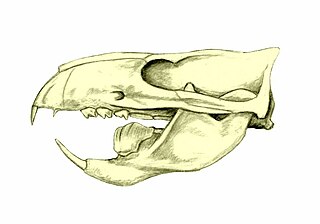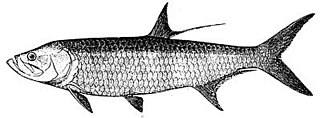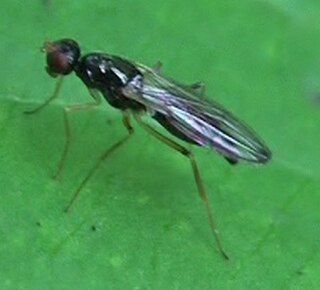
Weasels are mammals of the genus Mustela of the family Mustelidae. The genus Mustela includes the least weasels, polecats, stoats, ferrets and European mink. Members of this genus are small, active predators, with long and slender bodies and short legs. The family Mustelidae, or mustelids, is often referred to as the "weasel family". In the UK, the term "weasel" usually refers to the smallest species, the least weasel (M. nivalis), the smallest carnivoran species.

A wallaby is a small or middle-sized macropod native to Australia and New Guinea, with introduced populations in New Zealand, Hawaii, the United Kingdom and other countries. They belong to the same taxonomic family as kangaroos and sometimes the same genus, but kangaroos are specifically categorised into the four largest species of the family. The term "wallaby" is an informal designation generally used for any macropod that is smaller than a kangaroo or a wallaroo that has not been designated otherwise.

Ptilodus is a genus of mammals from the extinct order of Multituberculata, and lived during the Paleocene in North America.
Prochetodon is a genus of mammals from the extinct order Multituberculata. It lived during the Upper Paleocene and the Lower Eocene in North America. The genus was formally named by G. L. Jepsen in 1940.
Anconodon is an extinct genus of mammal from the Paleocene of North America, and thus lived just after the "age of the dinosaurs". It was a member of the extinct order Multituberculata within the suborder Cimolodonta and possibly the family Cimolodontidae.
Pentacosmodon is a mammal genus from the Paleocene of North America, so it lived somewhat after the "age of the dinosaurs". It was a member of the extinct order Multituberculata. It's within the suborder Cimolodonta and family Microcosmodontidae.

The Elopiformes are the order of ray-finned fish including the tarpons, tenpounders, and ladyfish, as well as a number of extinct types. They have a long fossil record, easily distinguished from other fishes by the presence of an additional set of bones in the throat.

Aphonopelma is a genus of tarantulas native to the Americas. It includes nearly all the North American tarantula species north of Mexico and a considerable percentage of the tarantula species that range into Central America. Most are fairly large tarantulas with leg spans of 6 in (16 cm) or more. Like most New World tarantulas, all species of Aphonopelma have urticating hairs. Despite their fearsome appearance, these tarantulas are not harmful to humans and some species are popular in the pet trade. With about 90 species described so far, Aphonopelma comprises about 10% of the total number of described tarantula species. However, their taxonomy is poorly understood and species are difficult to tell apart, especially those that are brown or black without other pattern. Therefore, the actual number of species is unknown, with more species likely to be identified in the near future. In captivity, they are usually fed crickets; in the wild, they eat most insects, including crickets, grasshoppers, cockroaches, mantises, and beetles.

The body whorl is part of the morphology of the shell in those gastropod mollusks that possess a coiled shell. The term is also sometimes used in a similar way to describe the shell of a cephalopod mollusk.

Pipefishes or pipe-fishes (Syngnathinae) are a subfamily of small fishes, which, together with the seahorses and seadragons, form the family Syngnathidae.

Pipunculidae is a family of flies (Diptera) commonly termed big-headed flies, a reference to the large (holoptic) eyes, which cover nearly the entire head. The family is found worldwide and more than 1300 species have been described.

Negaprion is a genus of requiem sharks in the family Carcharhinidae. It contains the two extant species of lemon sharks: the lemon shark of the Americas, and the sicklefin lemon shark of the Indo-Pacific. Both species are large, slow-moving, bulky sharks inhabiting shallow coastal waters, and can be identified by their short, blunt snouts, two dorsal fins of nearly equal size, and uniform yellowish brown or gray coloration.

Mesostigmata is an order of mites belonging to the Parasitiformes. They are by far the largest group of Parasitiformes, with over 8,000 species in 130 families. Mesostigmata includes parasitic as well as free-living and predatory forms. They can be recognized by the single pair of spiracles positioned laterally on the body.

Kano's mole is a species of mole endemic to Taiwan. The specific name kanoana is derived from Tadao Kano, a Japanese naturalist who made the first record of these animals in 1940s.

The Strongylophthalmyiidae are a small family of about 80 species of slender, long-legged flies, the majority of which occur in the Oriental and Australasian regions. They are divided into two genera, the monotypic Southeast Asian genus Nartshukia Shatalkin, 1993 and Strongylophthalmyia Heller, 1902. The relationships of the group are obscure; formerly the genus Strongylophthalmyia was classified with the Psilidae, and some recent classifications place it within the Tanypezidae. Little is known of their biology, but many species seem to be associated with rotting bark.

Seeleyosaurus is an extinct genus of plesiosaur that was initially placed within the genus Plesiosaurus in 1895 and was given its own genus in 1940. Two species were known: the type, S. guilelmiimperatoris, and the now obsolete species S. holzmadensis, which has since been absorbed into S. guilelmiimperatoris. The holotype was MB.R.1992, a large almost complete skeleton from the Upper Lias (Toarcian) Lias Group Formations of Württemberg, Germany. There seems to be the impression of a rhomboidal flap of skin in a vertical plane; if so, many plesiosaurs may have been equipped in this way. The holotype was destroyed in 1945 (WWII) and only a cast exists today. A second specimen, preserved in 3D, has survived until today. It was once the holotype of the now obsolete species S. holzmadensis.

Toxoderidae is a family of praying mantises.

Sitodiplosis mosellana, the wheat midge or orange wheat blossom midge, is a species of fly in the family Cecidomyiidae. It is found in the Holarctic, where it is a significant pest of wheat, triticale and rye.

Pipunculinae is a subfamily of big-headed flies.
Rosasia is an extinct genus of bothremydid pleurodiran turtle that was discovered in the Argilas de Aveiro Formation of Portugal. The genus consists of a single species, R. soutoi, named after Alberto Souto.
















